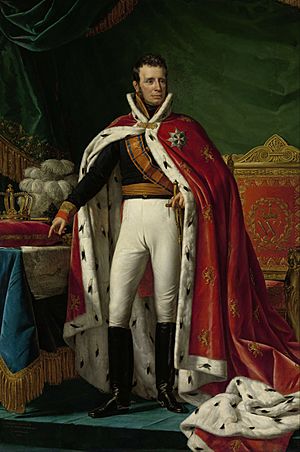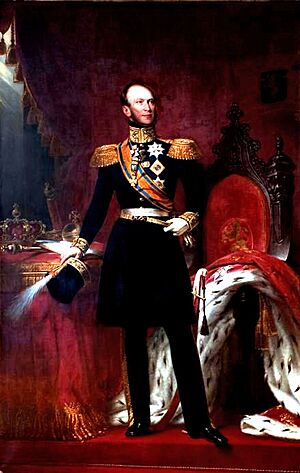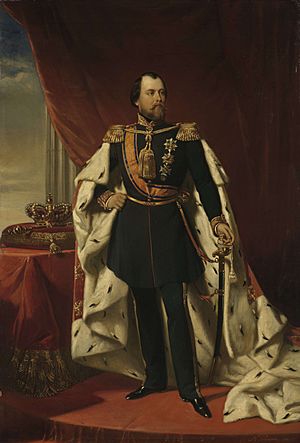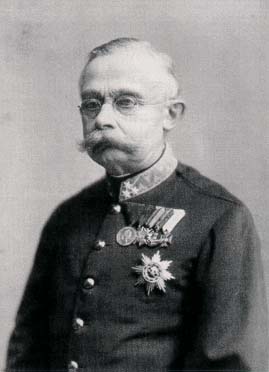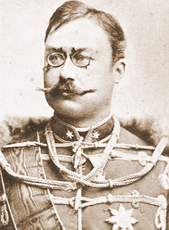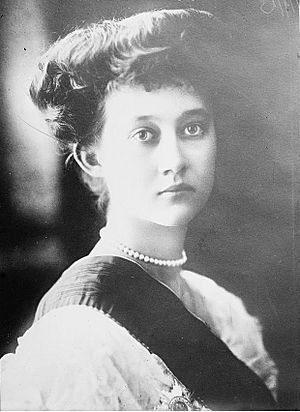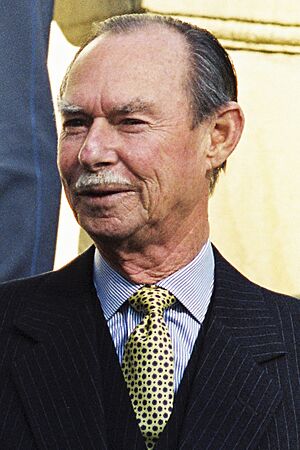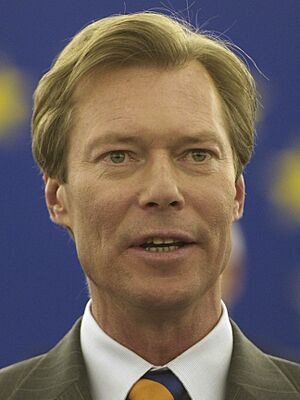Monarchy of Luxembourg facts for kids
Quick facts for kids Grand Duke of Luxembourg |
|
|---|---|
| Groussherzog vu Lëtzebuerg Grand-duc de Luxembourg |
|
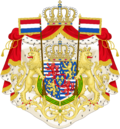
Arms of the Grand Duke of Luxembourg
|
|
| Incumbent | |
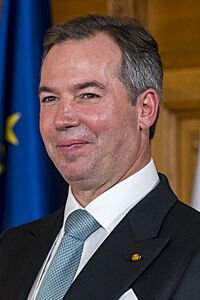 |
|
| Guillaume V since 3 October 2025 |
|
| Details | |
| Style | His Royal Highness |
| Heir apparent | Prince Charles of Luxembourg |
| First monarch | William I, King of the Netherlands, Grand Duke of Luxembourg |
| Residence | Grand Ducal Palace, Berg Castle, Colmar-Berg |
The monarchy of Luxembourg is led by the grand duke of Luxembourg. The grand duke is the head of state for the country. Luxembourg became a grand duchy on March 15, 1815. It was once connected to the United Kingdom of the Netherlands until 1890. Luxembourg is special because it is the world's only independent grand duchy. Since 1815, there have been ten monarchs. The current Grand Duke is Guillaume V.
Contents
What the Grand Duke Does
The constitution of Luxembourg explains the grand duke's role. He is the head of state and a symbol of the country's unity. He also makes sure Luxembourg stays independent. The Grand Duke helps run the government according to the country's laws.
In December 2008, a change was made to the constitution. Before this, the Grand Duke had to formally approve new laws. Now, he still announces the laws, but his personal approval is not strictly needed for a law to pass.
How the Grand Ducal Family is Supported
The Grand Duke does not receive a salary. However, the grand ducal family gets money each year to help with their official duties. In 2017, about €10.1 million was set aside in the country's budget for the grand duke's household expenses.
Who Inherits the Throne?
The rules for who becomes the next Grand Duke or Grand Duchess are called "succession." For a long time, these rules mostly allowed only male family members to inherit the throne. This was part of an old family agreement called the Nassau Family Pact.
In June 2011, the rules changed. Now, any legitimate child, whether male or female, can inherit the throne. This means daughters have the same right to become Grand Duchess as sons have to become Grand Duke.
The person who is next in line to the throne is called the "hereditary grand duke" once they turn eighteen.
The Grand Dukes of Luxembourg
Luxembourg has had ten monarchs since 1815. They belong to two main royal families.
House of Orange-Nassau
This family ruled Luxembourg from 1815 until 1890. They were also the kings of the Netherlands at the same time.
| Portrait | Name | Lifespan | Reign start | Reign end | Titles | Claim |
|---|---|---|---|---|---|---|
| Guillaume I | 24 August 1772 – 12 December 1843 |
15 March 1815 | 7 October 1840 (gave up the throne) |
King of the Netherlands; Grand Duke of Luxembourg |
Chosen by the Congress of Vienna | |
| Guillaume II | 6 December 1792 – 17 March 1849 |
7 October 1840 | 17 March 1849 | Son of William I | ||
| Guillaume III | 17 February 1817 – 23 November 1890 |
17 March 1849 | 23 November 1890 | Son of William II |
House of Nassau-Weilburg
When William III died in 1890, he had no sons. The rules for the Netherlands allowed his daughter, Wilhelmina, to become queen. But the rules for Luxembourg were different. They said that only male family members could inherit the throne unless there were no males left. So, the crown of Luxembourg went to Adolphe, from a different branch of the Nassau family.
Later, in 1907, Grand Duke William IV had only daughters. He made a law to confirm that his eldest daughter, Marie-Adélaïde, could become Grand Duchess. She was the first female ruler of Luxembourg. After she gave up the throne in 1919, her younger sister Charlotte became Grand Duchess. Her descendants have ruled Luxembourg ever since.
| Portrait | Name | Lifespan | Reign start | Reign end | Titles | Claim |
|---|---|---|---|---|---|---|
| Adolphe | 24 July 1817 – 17 November 1905 |
23 November 1890 | 17 November 1905 | Grand Duke of Luxembourg; Duke of Nassau |
Third cousin of William III | |
| Guillaume IV | 22 April 1852 – 25 February 1912 |
17 November 1905 | 25 February 1912 | Son of Adolphe | ||
| Marie-Adélaïde | 14 June 1894 – 24 January 1924 |
25 February 1912 | 14 January 1919 (gave up the throne) |
Grand Duchess of Luxembourg; Duchess of Nassau |
Daughter of William IV | |
| Charlotte | 23 January 1896 – 9 July 1985 |
14 January 1919 | 12 November 1964 (gave up the throne) |
Daughter of William IV Sister of Marie-Adélaïde |
||
| Jean | 5 January 1921 – 23 April 2019 |
12 November 1964 | 7 October 2000 (gave up the throne) |
Grand Duke of Luxembourg; Duke of Nassau |
Son of Charlotte | |
| Henri | 16 April 1955 | 7 October 2000 | 3 October 2025 (gave up the throne) |
Son of Jean | ||
| Guillaume V | 11 November 1981 | 3 October 2025 | Current Grand Duke | Son of Henri |

Grand Ducal Spouses
Here are the spouses of the Grand Dukes and Grand Duchesses of Luxembourg:
- Princess Wilhelmine of Prussia (wife of Grand Duke William I)
- Grand Duchess Anna Pavlovna of Russia (wife of Grand Duke William II)
- Princess Sophie of Württemberg (first wife of Grand Duke William III)
- Princess Emma of Waldeck and Pyrmont (second wife of Grand Duke William III)
- Princess Adelheid-Marie of Anhalt-Dessau (wife of Grand Duke Adolphe)
- Infanta Marie Anne of Portugal (wife of Grand Duke William IV)
- Prince Felix of Bourbon-Parma (husband of Grand Duchess Charlotte)
- Princess Joséphine-Charlotte of Belgium (wife of Grand Duke Jean)
- María Teresa Mestre y Batista (wife of Grand Duke Henri)
- Countess Stéphanie de Lannoy (wife of Grand Duke Guillaume V)
See also
 In Spanish: Anexo:Soberanos de Luxemburgo para niños
In Spanish: Anexo:Soberanos de Luxemburgo para niños
- Grand Ducal Family of Luxembourg


